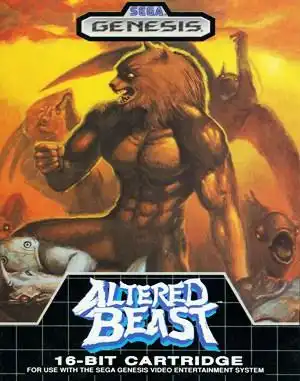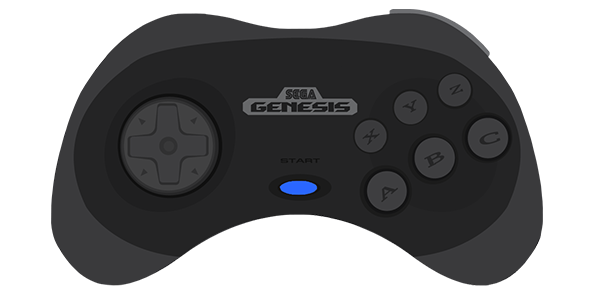The screen fades from black, a deep, gravelly voice booms, "Rise from your grave!" And just like that, you're a resurrected Roman centurion, ready to punch undead creatures and transform into mythical beasts. For many, this was the unforgettable introduction to the Sega Genesis, thanks to the legendary pack-in game, Altered Beast.
While perhaps not the deepest or most complex game ever made, Altered Beast holds a significant spot in retro gaming history. It was the first taste of 16-bit power for a generation, showcasing vibrant (for the time) graphics and that truly unique transformation mechanic. But how does this ancient Greek-inspired beat 'em up hold up today? Let's take a nostalgic trip back.
From Arcade Cabinets to Living Rooms
Before it landed in living rooms bundled with Sega's new console, Altered Beast started life in the arcades in 1988. Developed by Makoto Uchida (who would later work on Golden Axe), the game used Sega's powerful System 16 board, allowing for detailed sprites and smooth animation – especially those iconic transformations.
The premise is delightfully bizarre: Zeus, king of the gods, resurrects a dead warrior to rescue his daughter Athena from the evil demon Neff. Your mission is simple: walk right, punch and kick everything that moves, collect power-ups, and turn into a monster.
When the Sega Genesis (Mega Drive) launched in 1989, Altered Beast was chosen as the game to showcase its capabilities. It was a smart move – the arcade port was relatively faithful and immediately impressed players used to 8-bit systems.
Gameplay: Punching, Kicking, and Powering Up
At its core, Altered Beast is a side-scrolling beat 'em up. You control the centurion as he battles hordes of undead creatures, zombies, and mythological beasts across five levels set in Ancient Greece.
The key mechanic, and what everyone remembers, is the transformation. By defeating specific white wolves, you collect "Spirit Balls." Collect three, and your character bulks up dramatically before morphing into a powerful beast form unique to the level:
- Werewolf: Fast punches and fireballs.
- Werebear: Powerful ground pound.
- Weredragon: Flight and lightning breath.
- Were-tiger: Charging attack and fireballs (in some versions).
- Golden Werewolf: An upgraded version in the final level.
These forms aren't just for show; you must be in beast form to defeat the level boss, who is always Neff, usually transformed into a giant, grotesque creature himself. Fail to power up, and Neff just laughs and flies away, forcing you to repeat the stage.
The gameplay is straightforward, perhaps even simple by modern standards. Hit detection can feel a little off at times, and the levels are short. But the thrill of collecting those orbs and seeing your character transform was pure magic back in the day. And who can forget the garbled, yet memorable, voice samples like "Power Up!" and "Welcome to your doom!"?
Ports, Re-releases, and Where to Play Today
Altered Beast was incredibly popular, leading to ports on almost every system imaginable:
- PC Engine (TurboGrafx-16)
- Master System
- Famicom (with unique beast forms!)
- Atari ST, Amiga, Commodore 64, ZX Spectrum, Amstrad CPC
The Genesis version remained the most well-known due to its pack-in status. Over the years, it's been included in countless Sega compilations and digital re-releases:
- Sega Genesis Mini: Included on the microconsole.
- Sega Forever (Mobile): Playable on iOS and Android.
- Digital Stores: Available on platforms like PlayStation Network, Xbox Live Arcade, and the Nintendo Switch Online + Expansion Pack service.
- PC: Often found in Sega compilations on Steam or GOG. You can even find the original DOS version on sites like Archive.org, often playable via DOSBox.
Finding a way to play Altered Beast today is easier than ever, letting new generations experience this piece of history.
Reception and Legacy: More Than Just a Pack-In?
Upon release, Altered Beast received generally positive reviews, especially the arcade and Genesis versions, praised for their graphics and unique theme. However, some critics found the gameplay repetitive or shallow.
Over time, opinions became more mixed. While undeniably iconic, many later reviews noted its simplicity and short length compared to other beat 'em ups that followed. It's often cited as a game that hasn't aged particularly gracefully.
Yet, its legacy is undeniable. The "Rise from your grave" line is legendary. The transformations are etched into the memories of Genesis owners. It was the game that introduced millions to the Sega Genesis and helped establish Sega as a major player in the console wars. It even spawned a couple of sequels, though none reached the fame of the original.
Does Altered Beast Hold Up Today?
Let's be honest: playing Altered Beast now, stripped of the pure novelty of 16-bit graphics and the excitement of a new console, reveals a fairly basic game. The controls can feel stiff, the levels are short, and the challenge often comes from cheap hits rather than deep combat.
However, if you approach it with a dose of nostalgia or an appreciation for arcade history, there's still fun to be had. It's a quick playthrough, perfect for a short burst of retro action. Experiencing those transformations, hearing those voice clips, and battling Neff one more time can be a genuinely enjoyable trip down memory lane.
It might not be the best beat 'em up ever made, but Altered Beast is a bonafide classic for its cultural impact and its role in the early days of the 16-bit era. It's a game that rose from the grave and left an indelible mark on gaming history.
Quick FAQ
Q: Why was Altered Beast the pack-in game for the Genesis?
A: Sega wanted a game that showcased the Genesis's arcade-quality graphics and sound, similar to their System 16 arcade board. Altered Beast was a popular arcade title at the time and fit the bill perfectly, demonstrating a clear leap over 8-bit consoles.
Q: What are the different beast forms you can transform into? A: In the Genesis version, you can transform into a Werewolf, Werebear, Weredragon, and Were-tiger, plus a Golden Werewolf in the final level. Other versions, like the Famicom port, had unique forms like a shark or phoenix.
Q: Is there a sequel to Altered Beast? A: Yes, there's Altered Beast: Guardian of the Realms for the Game Boy Advance (2002) which follows the original style, and a darker, unrelated reboot simply titled Altered Beast for the PlayStation 2 (2005).
Q: Can I play Altered Beast on modern consoles or PC? A: Absolutely! It's available on many digital stores (PlayStation, Xbox, Switch Online), mobile (Sega Forever), PC compilations (Steam, GOG), and included on the Sega Genesis Mini. You can also find the original DOS version on Archive.org.


